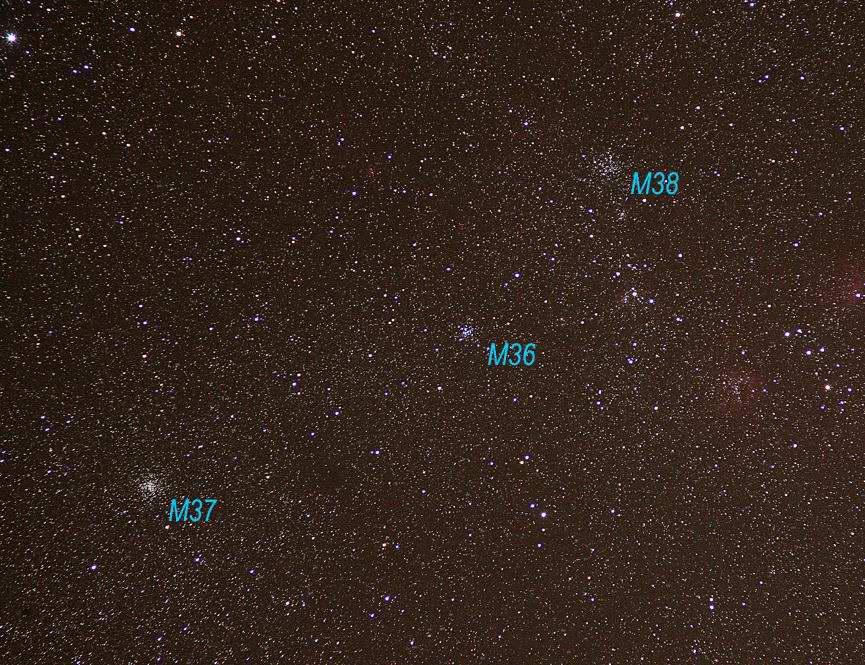Stargazing

|
The Constellation Auriga |

|
- The star β (beta) Tauri marks the tip of
the Bull's northern horn. This star is actually shared with another
constellation, Auriga the Charioteer, which forms a bright five-sided
figure. {Trace out Auriga}
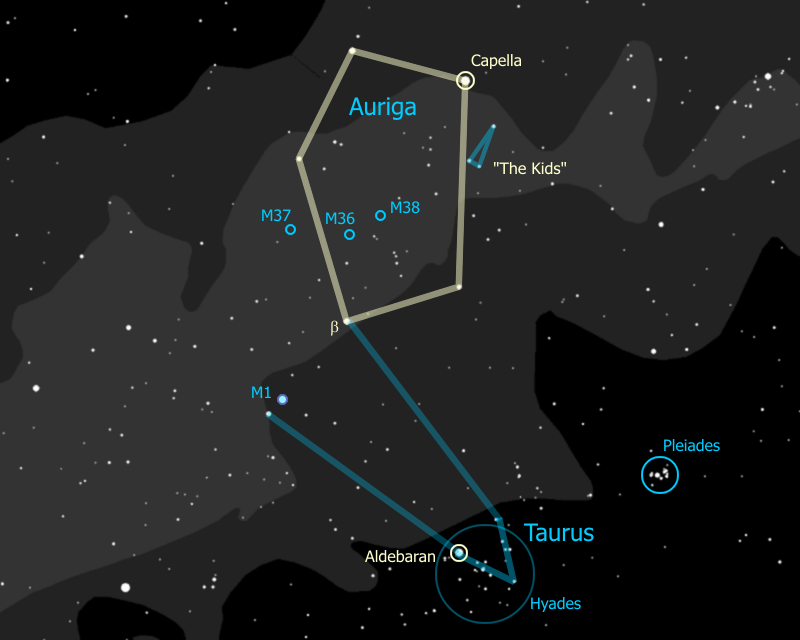
Auriga is often shown seated and holding a young goat in his arms, represented by the small thin triangle of stars along the right side of the pentangle. These stars are known as "The Kids". The star at the tip of this triangle is ε (epsilon) Aurigae. This is one of the brightest stars in our galaxy, a huge star 2,000 light years away which, every 27 years, is eclipsed by something even huger -- eclipsed for two full years.
The mystery of how this happens may have been solved very recently -- in January of 2010 the theory was presented that ε Aurigae is a dying star, with twice the mass of the sun and blown up to 100 times the diameter of the sun, whose outer shells are being blown off, captured, and formed into a disk by an orbiting companion star. It is this disk, which we are seeing edge on, that is periodically dimming ε Aurigae.
Artist's Conception of Epsilon Aurigae in Eclipse 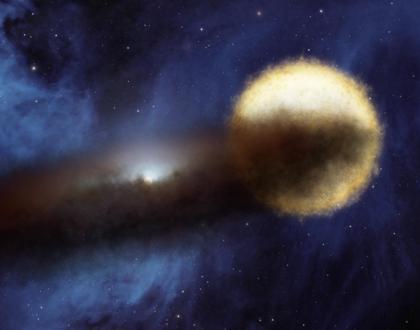
- The brightest star in Auriga is "Capella". Part of the reason it's
so bright is because it's pretty close, 45 light years away. That
makes it a little less than half the distance to the Hyades cluster.
In fact, it is moving in space at the same speed in the same direction
as the Hyades, and may be an "outlier" of that group. Another reason
it's so bright is that it is really two stars orbiting one another,
too close for us to see in the telescope. Capella is an important
star for navigation because it's among the brightest stars in the sky,
and because it's so far north that you can see it nearly all year
round.
- So what do you think, is Capella the brightest star in the sky right
now? Do you see any stars you think might be even brighter? See that
star way to the south? That star is Sirius, the second closest to
our sun of all the naked-eye stars. (Only Alpha Centauri is closer.)
Which is brighter, Capella or Sirius? Which do you think is brighter,
Capella or Aldebaran? How about β Tauri,
which is brighter, Aldebaran or β Tauri?
Astronomers measure star brightness using 'magnitudes' -- Capella has a magnitude of 0, Aldebaran has a magnitude of 1, β Tauri has a magnitude of 2. As magnitude number goes up, brightness goes down. A magnitude 1 is 2½ times as bright as a magnitude 2, a 2 is 2½ times as bright as a 3, and so on.
This comes from the system set up by ancient Greeks, where the brightest stars were stars of the first magnitude, like 'first class', and the faintest stars you could see were stars of the sixth magnitude. When astronomers got telescopes and instruments that could measure star brightness, they found 1st magnitude stars were almost exactly 100 times the brightness of 6th magnitude stars. That works out to a factor of 2½ from one magnitude to the next.
Magnitudes can go negative for stars brighter than 0 magnitude Capella. Sirius is the brightest star anywhere in the sky (any time of the year) with a magnitude -1.5.
Well, what's really the brightest star in the sky? The sun has a magnitude of -27.
- It's not only the brightness of each star that is different. Look at
Betelgeuse and Rigel. Can you see a difference in color between these
two stars? Betelgeuse is red, and Rigel is more blue. Look at Capella
and tell me what color that might be. It's more of a yellow color, isn't
it? How about the stars of Orion's belt? Those stars are really blue,
aren't they? You can see the colors even better when you examine the
stars in binoculars or a telescope. So what do the star colors mean?
Why would one star be blue and another red?
Yup, that's right. Different colors show different temperatures. So which star color is the hottest? Just like a flame, blue is the hottest part, yellow is next, red is the coolest. The sun is a yellow star, about 10,000°F at the surface. A red star is about half the sun's surface temperature, whereas a blue star is three to five times as hot as the sun. White stars like Sirius are somewhere between the yellow ones and blue ones.
Now, all stars are made of pretty much the same stuff -- about 90% hydrogen and the rest is helium with some traces of other stuff. So, why would one star be burning hotter than another? The answer is in the size of the star. The more massive it is, the more pressure there is at the center and therefore the hotter - and for that matter the brighter - the star burns. So blue stars are the biggest and brightest of stars, and red stars are the smallest and dimmest.
So why is red Betegeuse so bright? Hmmm... yeah... well, like with most rules, there are exceptions to the rule, and this rule is no exception. Betelgeuse is a star that is literally running out of gas. As a star burns up all the hydrogen at its center, it starts to burn helium (which is the "ash" from the hydrogen burning), which makes it expand, get brighter, and turn red -- it becomes a red giant. This is the time you can get a bright red star, when the star is near the end of its life.
When our sun starts burning out it will expand so big it will swallow up Mercury and Venus and scorch the surface of the earth to a cinder. If you are hoping to see all that happen you will have to wait about 5 billion years.
So there are two reasons a star could be red -- it is massive (and once was yellow, white or even blue) and is now burning out (a red giant), or it never had enough mass to burn any hotter than red (a red dwarf).
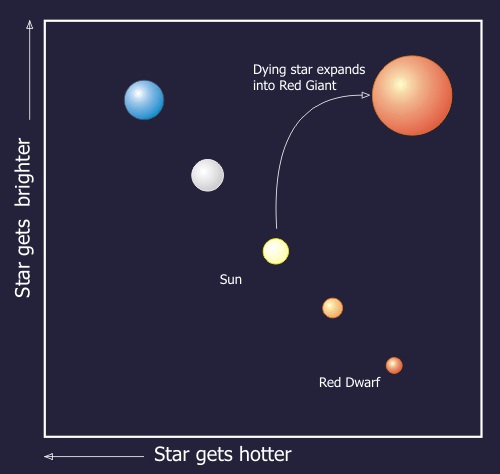
Notice that when we graph out the stars showing their temperature (or color) against their brightness, most of them fall along a line -- this line is called the Main Sequence, and the graph is called the "H-R" (for Hertzsprung-Russell) Diagram. Others are not on the main sequence, mostly stars that are either just being born (called "T-Tauri" stars) or stars that are near the end of life.
- Now even though it is a red super-giant near the end of it's life, Betelgeuse
is actually a very young star, at least compared to the sun. Betelgeuse was
born only about 6 million years ago, long after the Dinosaurs died out, and is
nearly at the end of its life already. This is because Betegeuse is so much
more massive than the sun. The greater mass causes greater pressure and
forces the star to burn hotter (bluer) and faster.
So Betegeuse was once a blue supergiant with 15 times the mass of the sun, burning 60,000 times as fast as the sun, and looked a lot like Rigel does today. Its life as a star will be less than one thousandth as long the sun will live (the sun, and the very earth you're standing on, are nearly 5 BILLION years old and our sun is good for about another 5 billion years). With stars, the bigger they are, the harder they fall.
Betelgeuse is so big we can measure its size even at 600 lightyears away. Moreover, since 1993 it has gotten 15% smaller, so there is now speculation that it might go supernova in the next few years. If that turns out to be right, and since its light takes 600 years to reach us, that would mean that Betelgeuse has already exploded!
- Note - we might have the following discussion any time
during the sky tour, whenever it comes up.
Auriga lies right across the Milky Way and therefore contains lots of interesting stars and star clusters.
Someone want to tell me what that means -- "The Milky Way"? Where is the Milky Way (someone will always point it out). Most people recognize the Milky Way as a band of light across the night sky, but what is that band of light - where does it come from?Well it's a bit like looking at a gravel road. Close to you, you can see individual stones, while off in the distance the road merges into a uniform gray. When you look at the Milky Way you are looking at the disk of our galaxy from the inside - the nearby stars you can see individually (most are less than 1,000 light years away), the distant stars merge into a hazy glow. So when you see that band across the sky you are really looking way off into the distance, into the "billions and billions" of stars that make up the disk of our galaxy.

You'll see a similar phenomenon when we look at the more distant galactic clusters. Through binoculars you see them as a hazy patch. When you see them through a telescope - that is, closer up - you can pick out individual stars. The better the telescope, the 'closer' you can get to the cluster, the more stars you can see.
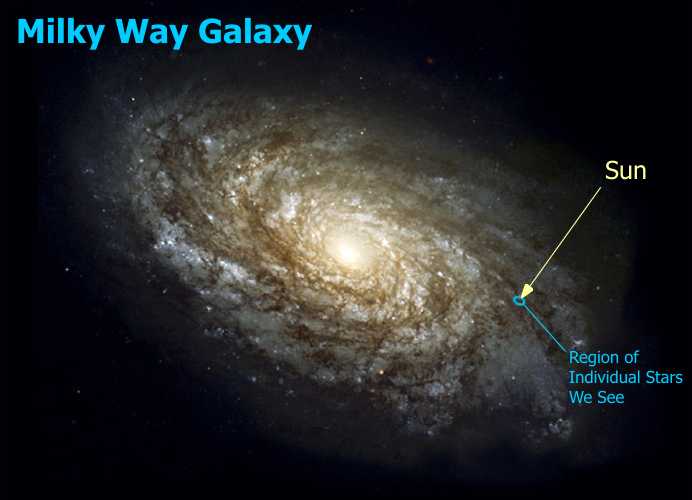
- Let's look for some of those faint fuzzies. We can see them as little
fuzzballs in the binoculars, and they get more interesting if we can
get the telescope on them.
M36 is found just inside the center of eastern edge of the five-sided figure of Auriga. This is a galactic cluster just like the Pleiades, and would look a lot like the Pleiades to us, except that it is 10 times farther away. The Pleiades is at a neighborly 400 lightyears distance, M36 is waving at us from 4000 lightyears away. Notice though, how, like the Pleiades, this is a group of all bright blue stars, and like the the Pleiades, it is very young (~25 million years old).
To the right of M36, within the same binocular field of view, is M38. In the telescope, if you stare hard, you can see a cross shape to this cluster. Can you spot the yellow giant among the younger, blue stars? The giants, stars which are reaching the end of their life, are used to determine the age of the cluster - the fewer blue stars, the more red & yellow giants, the older the cluster. M38 is quite a bit older than M36, at about 200 million years.
To the left of M36, just outside the eastern edge of Auriga, is M37. This is a large and colorful cluster with many older stars and hence is older still than M38, at about 300 million years. This cluster is considered to be the finest and most beautiful of all galactic clusters. All three of these clusters lie at about the same distance away, 4000 light years, and are estimated to have about a 100 or so stars.
- Assuming it's an extra-clear, dark night and you've checked
that you can see the Crab, or if you have a highly serious group, you can go
after this important astronomical landmark. Otherwise skip this part or
mention it in passing. Even on a good night it's tough to see.
We will now move to the tip of the southern horn of Taurus, the star known as ζ (zeta) Tauri. Almost exactly one degree to the northwest of ζ Tauri we will find another faint fuzzy patch. This one we cannot resolve into individual stars, no matter how much magnification we put on it.
The designation on this object is "M1", the first item in the Messier catalog, commonly known as the "Crab Nebula". This was the object that originally inspired Charles Messier to make his famous list, because he confused it with a comet until he realized it was not moving.
Crab Nebula in Telescope What you're looking at 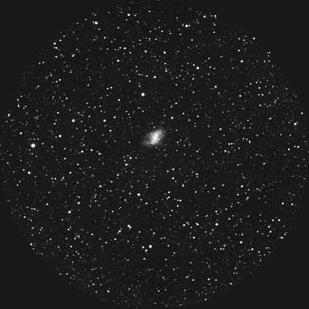
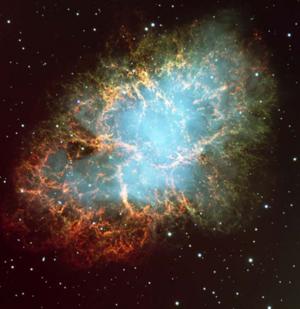
What you are actually looking at is the rapidly expanding cloud of gas that used to be a star until it exploded in a supernova in the year 1054. According to historical records the supernova was so bright you could see it during the daytime for nearly a month. In a high-powered telescope you can actually see filament structures which to one early astronomer looked like the legs of a crab, hence the name. The gas cloud is expanding at 1,000 miles a second!
At the center of this gas cloud is a neutron star, with a mass equivalent to our sun in a ball 20 miles across (the sun is 800,000 miles across) and spinning at 30 times a second. It is a pulsar and a radiation monster. It is a strong radio source and also a bright X-ray source (and everything in between), putting out 100,000 times more energy than the sun.
We are looking at it from the safe distance of 6300 light years away. If the original supernova had been closer to us, say, as far as Capella, the radiation from the blast would have wiped out all life on earth. On the other hand, in a huge cosmic irony, we wouldn't be here at all if it weren't for supernovas like this one. The universe is made up only of hydrogen and helium, all the heavier elements, like the ones we are made of -- carbon, oxygen, iron, the calcium in our bones, are all created in supernova explosions.
So technically speaking, you are stardust.
 |
 |
 |
| Back to Orion & Taurus | Go to Winter Index | On to Andromeda |
Questions
Your questions and comments regarding the Stargazing section are welcome.
You can e-mail the author, Randy Culp for inquiries,
suggestions, new ideas or just to chat.
Updated 18 July 2023

